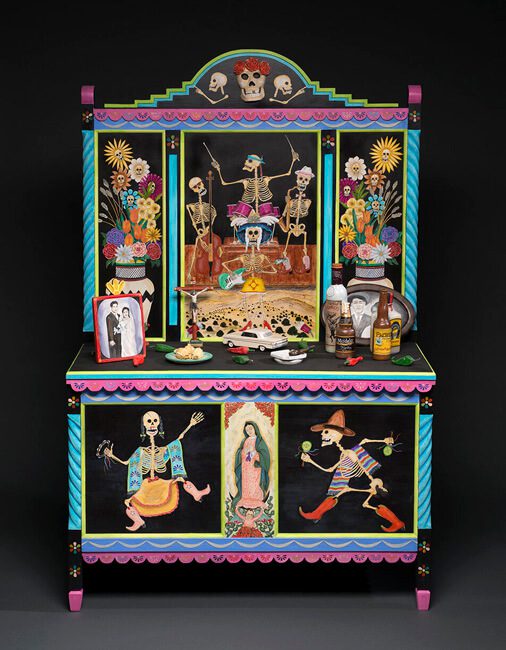Justin Favela, Luis Tapia, and Rose B. Simpson are recipients of the inaugural Joan Mitchell Fellowship, which gives awardees unparalleled recognition and $60,000 in unrestricted funds.

ALBUQUERQUE, NM—The “studio” of Las Vegas, Nevada installation artist Justin Favela is the garage at his home, which includes all sorts of built-in limitations and frustrations. Additionally, Las Vegas, like many urban centers throughout the country, is pricing out creatives.
Last month, Favela’s future sustainability as an artist, who’s attempting to survive in a city nailed by inflation, took a major positive turn.
On October 13, the New York City-based Joan Mitchell Foundation announced the recipients of its inaugural Joan Mitchell Fellowship, which gives awardees $60,000 in unrestricted funds over a five-year period. Favela is one of three artists in the Southwest and only fifteen recipients nationwide of the fellowship for artists working in painting and sculpture. Luis Tapia (Santa Fe) and Rose B. Simpson (Santa Clara Pueblo) also received the big-deal fellowship, which provides professional development services in addition to financial support.
“It feels very validating to get an award like this,” says Favela, whose large-scale sculptures comment on American pop culture and the Latinx experience. “The fact that the funds are unrestricted is also amazing. I’ve really been wanting to have a bigger and more sustainable studio space in Vegas so I think this is definitely going to help push me to realize that dream.”
The fifteen recipients, which include artists living in the major New York City boroughs, Los Angeles, and Seattle, were among a pool of 166 artists who had been anonymously nominated.

“I got a phone call out of nowhere. It was quite exciting,” says Tapia, a Chicano artist who creates figurative wood sculptures rooted in folk art. “The nomination was probably the most important part to me. To know that there’s somebody out there viewing your work that’s not a client or anything like that. To feel that your work is deserving of this award is incredible.”
Tapia plans to use the $60,000 to purchase materials and pay rent on his studio space, where he’s monastic about his practice—he spends a minimum of five to six hours days, seven days a week creating works that have been purchased by the Museum of International Folk Art in Santa Fe, the Columbus Museum of Art in Ohio, the National Museum of Mexican Art in Chicago, and the Denver Art Museum. In 1996, Tapia received the New Mexico Governor’s Award for Excellence in the Arts, the state’s highest artistic honor.
“Financially, you have to continue making money to continue your work. These funds help alleviate a little bit of that pressure,” says Tapia.
Favela, who recently exhibited at the Amon Carter Museum of American Art in Fort Worth, Texas, doesn’t necessarily work in a traditional studio environment. That’s due to his current spatial restraints and also because, pre-pandemic, he often traveled stateside and internationally to install his sculptures. He says the fellowship can allow him to have the best of both worlds.
“Having a physical place where I can be and share it with my friends and with some of my community would be so special,” Favela says. “Even if I’m gone doing an installation, I know that that space will still be in good use.”
(Southwest Contemporary was unable to connect with Rose B. Simpson prior to press time.)




